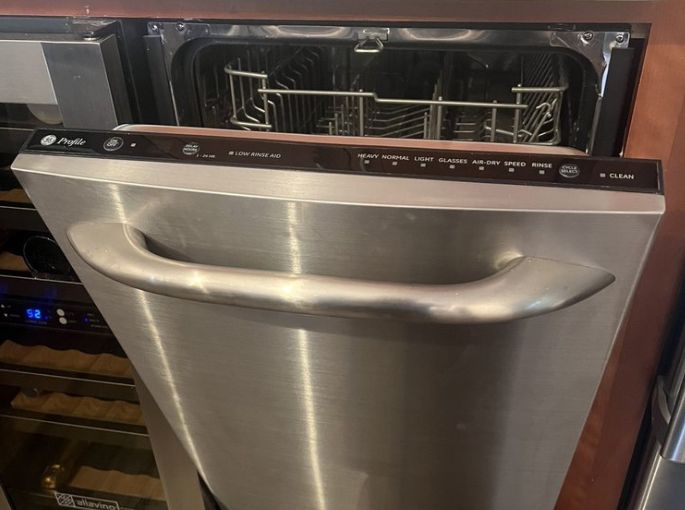
Dishwashers are a common household appliance that have become a staple in most modern kitchens. They offer a convenient way to clean dishes, cutlery, and cookware, saving time and effort. However, there are many facts about dishwashers that people may not be aware of.
One interesting fact about dishwashers is that they use less water than washing dishes by hand. According to the Environmental Protection Agency, a dishwasher uses an average of 3-5 gallons of water per cycle, while hand washing can use up to 27 gallons of water. This means that using a dishwasher can help to conserve water and reduce your utility bills.
Another important fact about dishwashers is that they require regular maintenance to function properly. Over time, food particles and mineral deposits can build up in the dishwasher, leading to clogs and poor performance. It is recommended to clean the dishwasher’s filter and spray arms regularly, and to use a dishwasher cleaner to remove any buildup. By taking proper care of your dishwasher, you can ensure that it continues to work efficiently and effectively.

History and Development
Invention of the Dishwasher
The first dishwasher was invented in 1886 by Josephine Cochrane, a wealthy socialite who was tired of her servants breaking her china while washing it by hand. She created a machine that used water pressure to clean dishes, and it was a huge success. However, dishwashers did not become widely used until the 1950s, when they became more affordable and reliable.
Technological Advancements
Over the years, dishwashers have undergone many technological advancements.
In the 1960s, dishwashers started to have built-in heaters to dry dishes.
1970s – dishwashers became more energy-efficient,
In the 1980s, they started to have multiple wash cycles.
And in the 1990s, dishwashers started to have sensors that could detect how dirty the dishes were and adjust the wash cycle accordingly.
Today, dishwashers have even more advanced features, such as Wi-Fi connectivity and voice control.
Global Adoption
While dishwashers are very popular in countries like the United States and Japan, they are not as common in other parts of the world. In many European countries, for example, it is still common to wash dishes by hand. However, as more people around the world become aware of the benefits of dishwashers, their popularity is growing. In fact, the global dishwasher market is expected to continue to grow in the coming years, driven by factors such as rising disposable incomes and changing lifestyles.
Design and Components
Basic Structure
Dishwashers are typically rectangular and are designed to fit under a standard kitchen countertop. They are made up of several main components, including the tub, spray arms, detergent dispenser, racks, and control panel.
The tub is the main body of the dishwasher and is where the dishes are placed for cleaning. The spray arms are responsible for distributing water and detergent throughout the tub to clean the dishes. The detergent dispenser releases detergent at the appropriate time during the wash cycle. The racks hold the dishes in place and are adjustable to accommodate different sizes and shapes of dishes. The control panel allows the user to select the appropriate wash cycle and other options.
Washing Mechanism
Dishwashers use a combination of water, detergent, and heat to clean dishes. The water is heated to a high temperature and sprayed onto the dishes through the spray arms. The detergent helps to break down food particles and grease, while the heat helps to sanitize the dishes.
Some dishwashers also use a pre-rinse cycle to remove any large food particles before the main wash cycle. This can help to improve the overall cleaning performance of the dishwasher.
Drying Technologies
There are several different drying technologies used in dishwashers, including heated drying, air drying, and fan-assisted drying. Heated drying uses a heating element to dry the dishes, while air drying uses natural air flow to dry the dishes. Fan-assisted drying uses a fan to circulate air and speed up the drying process.
Some dishwashers also feature a rinse aid dispenser, which can help to improve the drying performance of the dishwasher by reducing water spots and improving water sheeting.
Environmental Impact
Water Efficiency
Dishwashers are designed to use less water than washing dishes by hand. The average dishwasher uses about 6 gallons of water per cycle, while washing dishes by hand can use up to 27 gallons of water. However, it’s important to note that older dishwashers may not be as water-efficient as newer models. Most modern dishwashers are equipped with sensors that detect how dirty the dishes are and adjust the amount of water used accordingly.
Energy Consumption
Dishwashers use electricity to power the various components of the machine, including the heating element, pump, and motor. The amount of energy used by a dishwasher can vary depending on the model, age, and efficiency rating. Energy Star certified dishwashers are designed to use less energy than standard models, which can result in significant savings on utility bills over time. It’s also worth noting that running the dishwasher during off-peak hours can help reduce energy usage and save money.
Detergent Usage
Using too much detergent in a dishwasher can be harmful to the environment. Excess detergent can cause excessive foaming and lead to clogs in the machine’s plumbing. It’s important to use the correct amount of detergent recommended by the manufacturer. Additionally, using eco-friendly detergents can help reduce the environmental impact of dishwashing. These detergents are designed to be biodegradable and free of harmful chemicals.
Overall, dishwashers are a convenient and efficient way to clean dishes. However, it’s important to choose a model that is energy-efficient and use it responsibly to minimize the environmental impact.
Usage and Maintenance
Proper Loading Techniques
Proper loading techniques are essential to ensure that the dishwasher cleans dishes effectively and efficiently. Here are some tips to help you load your dishwasher correctly:
- Place dishes in the dishwasher with the soiled side facing the center of the machine.
- Make sure that dishes are not touching each other to allow water and detergent to reach all surfaces.
- Avoid overcrowding the dishwasher, as this can prevent proper cleaning and drying.
- Load glasses and cups on the top rack, facing down to prevent water from collecting in the rims.
- Load plates, bowls, and utensils on the bottom rack, facing the center of the dishwasher.
Cleaning and Care
To keep your dishwasher running smoothly, it is essential to clean and maintain it regularly. Here are some tips to help you care for your dishwasher:
- Clean the interior of your dishwasher with a soft cloth and mild detergent.
- Remove and clean the dishwasher filter regularly to prevent clogs and ensure proper drainage.
- Run a cleaning cycle with a dishwasher cleaner to remove any buildup or residue.
- Check the spray arms for clogs and clean them if necessary.
- Clean the dishwasher door and gasket regularly to prevent mold and mildew growth.
Common Issues and Solutions
Even with proper usage and maintenance, dishwashers can experience issues. Here are some common problems and solutions:
- Dishes not getting clean. Check that the dishwasher is loaded correctly and that the spray arms are not clogged. Use a dishwasher cleaner to remove any buildup or residue.
- Dishwasher not draining. Check that the drain hose is not clogged or kinked. Clean the dishwasher filter and remove any debris from the drain pump.
- Dishwasher leaking. Check that the dishwasher door is properly sealed and that the gasket is not damaged. Replace the gasket if necessary.
10 interesting facts about dishwasher
- The first dishwasher was invented in 1886 by Josephine Cochrane, who wanted a more efficient way to wash dishes.
- Dishwashers use less water than handwashing, saving an average of 5,000 gallons of water per year.
- The average dishwasher can hold around 12 place settings, which is equivalent to 144 items.
- Dishwashers use hot water and detergent to remove food and grease from dishes, then rinse them with clean water.
- The most common dishwasher cycle is the “normal” cycle, which typically lasts around 2 hours.
- Some dishwashers have a “sanitize” option that uses high heat to kill bacteria on dishes.
- Dishwashers have a filter system to capture food particles and prevent them from clogging the dishwasher’s drain.
- The first commercially successful dishwasher was introduced in 1950 by KitchenAid.
- Some modern dishwashers have sensors that detect how dirty the dishes are and adjust the wash cycle accordingly.
- Dishwashers have become a staple in most households, with over 75% of American homes having a dishwasher.
Read more: No More Stains: Remove Ink from Dryer Effortlessly